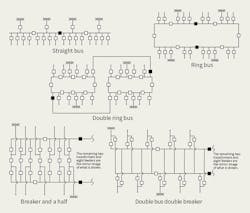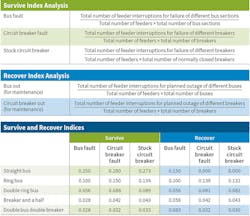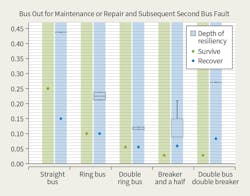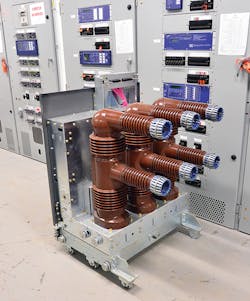ComEd Updates Substation Design
Distribution system planners live in a weather-normalized Brigadoon sort of world that exists in reality only once every 10 years or so. However, on a daily basis, they work with a couple of immutable laws, namely Ohm’s Law and Murphy’s Law.
Faced recently with a portfolio of substation-hardening and capacity-expansion projects, distribution capacity planners from Commonwealth Edison (ComEd) introduced an engineering effort to study existing 138/34.5-kV substation designs — with a specific focus on the 34.5-kV bus arrangement — to identify ways in which to integrate resiliency, reliability and operational improvements into an updated design. This study brought together experts from ComEd’s substation design, maintenance, protection and other groups
History and Reality
A design standard was needed that would satisfy both Ohm and Murphy. Before delving into the methodology used to compare several possible substation bus designs and select one as a new standard, it is important to understand some things about ComEd and its 34.5-kV distribution system. For more than 100 years, ComEd has been powering the lives of 3.9 million customers spread across northern Illinois, U.S. Like other major utilities, ComEd has a large inventory of substations that supply distribution feeders by way of an assortment of medium-voltage bus arrangements. Roughly 20% of ComEd’s system load and 15% of its customers are served from 34.5-kV feeders out of these substations. Much of this equipment was installed between the post-World War II era and the early 1970s.
After decades of successful service, upgrades to these substations as well as additions to the substation fleet are now taking place to continue to meet the reliability expectations of the 21st century. Based on the magnitude of these capital investments and the number of customers who count on these assets for service, it is critical design decisions are made wisely.
ComEd is providing record reliability, enhanced customer care and innovative savings programs, and seeing record customer satisfaction as a result. Strategic partnerships with state and regional development stakeholders to expand Illinois’ diverse business base have been successful, and Illinois’ economic growth depends on the utility continuing to deliver safe and reliable power. ComEd’s service territory is now one of the most active markets for new data center development. The suburban Chicago, Illinois, data center market is seeing an influx of new providers, many of whom take service at 34.5 kV, thereby increasing the need for dependable 138/34.5-kV substations built on a solid design.
More Than Just Amps
Low-side buses at ComEd’s legacy 138/34.5-kV substations are constructed with outdoor open-air buses, disconnects, circuit breakers and other equipment. Although it was state of the art when originally designed and installed, this type of equipment has always been inherently vulnerable to wildlife, weather and other exposure-related outages.
The legacy ComEd system includes three basic 34.5-kV bus designs: the straight bus, the ring bus and the double ring bus. Each of these designs allows for 138/34.5-kV transformers to be operated in parallel in normal configuration, and variations exist on all three designs.
In the early 2000s, ComEd began installing modular sheltered-aisle 34.5-kV switchgear at new substations. ComEd had been using similar gear on its 12.5-kV system for more than a decade, and the application of this equipment on the 34.5-kV system brought not only the obvious reduction in medium-voltage equipment exposure but also proven 12.5-kV design benefits like fewer feeders per bus section, buses configured in a ring to provide two-direction sourcing for each bus section and the ability to continue parallel operation of transformers during equipment outages.
A fully developed 138/34.5-kV substation at ComEd employs four transformers serving as many as 16 34.5-kV feeders. ComEd’s distribution system is generally planned and forecasted with the goal of serving all customer electric load under system normal (N-0) and first transformer contingency (N-1) conditions. In some cases, second transformer contingency
(N-2) conditions also are considered.
During this study, ComEd gave considerable attention to the 34.5-kV bus configuration at these substations, analyzing and comparing five potential bus designs: straight bus, ring bus, double ring bus, breaker and a half, and double bus double breaker. In comparing these different bus designs, the engineering team applied five guiding principles:
• Reliability for isolating faults while minimizing impacts to healthy equipment
• Operability for reconfiguring under contingencies to match available transformer capacity with connected load
• Feasibility to be scalable as well as built in a variety of physical locations on the system
• Interchangeability to leverage existing maintenance and operating methods and expertise
• Cost for balancing sound economic responsibility with the other four guiding principles.
Evaluation Indices
One of the greatest challenges the team encountered was creating a quantifiable methodology for comparing the different bus designs. Discussions sometimes became clouded by opinions about the importance of cost versus reliability, for instance, or what exactly flexible operability looks like, or how important it is to have a scalable design, or one that can be built in stages and in many places on the system. Engineers are passionate people, and it usually takes sound logic to influence their thinking.
ComEd developed a reliability index approach to compare the five possible 34.5-kV bus configurations. The transmission study from which these indices were adapted — “SCECO-East Experience with Switchgear Arrangement of Transmission Substations” by Zafar Choudhry, 1995 — essentially assigned a relative value to a design based on the number of its elements subject to outage for various fault modes, accounting for all possible instances of each mode. The analysis considered strictly feeder outages because they represent direct customer impact. ComEd also considered physical metrics and cost, calculated simply as a square foot and dollar multiple of the number of circuit breakers required for each configuration.
Survive or Recover
If reliability were the only consideration, the double bus double breaker would have been the clear champion for initial impact to feeders under every type of fault. However, a deeper review of what these fault situations would look like in real life led ComEd to further assess the impact to feeders to make repairs to faulted equipment. Enlightening conversations with switchgear vendors and ComEd’s own substation maintenance experts revealed some important facts.
Because of the complexity of the designs and compact nature of the buildings, one significant drawback of the breaker and a half as well as the double bus double breaker in a modular switchgear lineup is the amount of equipment that would have to be taken out of service to provide the necessary clearance for crews to make repairs to a faulted bus section. To capture this significant aspect of the utility’s findings, a second reliability index was added for each fault mode. The initial impact index was renamed the Survive Index and the new index was called the Recover Index. The recover indices also are useful for comparing maintenance impact for bus and circuit breaker outages.
These substations are planned for transformer N-1, so typical engineers could feel they have gone the extra mile by looking beyond the mere loss of a transformer, studying the assorted first contingency survive index rankings and stopping at the first contingency recover indices. However, in the spirit of the second immutable law, Murphy’s Law, distribution planning engineers cannot help but take a look under the hood of each of these configurations to get a feel for the depth of resiliency they present. Having a bus section out for maintenance or repair, and then being forced into a survive situation because of a second bus fault is both the worst second contingency scenario and not an unreasonable circumstance to expect at some point during the life of a substation.
The graph illustrates the relative depth of resiliency of the five configurations that were studied. The first contingency survive and recover indices are represented by the diamond markers. The box plots show the range of survive indices for a bus fault with one bus initially out for maintenance.
The difference between the survive and recover index values and the depth of resiliency data for each bus arrangement can be thought of as in indication of the risk that is present during bus maintenance or repair activities. For some of these designs, the first contingency maintenance outage in and of itself is an operating hardship; the impact of a second contingency while that work is underway is catastrophic.
Double Ring Bus Recommendation
The quest for a better substation is never ending and ComEd continues to explore additional design features that could add resiliency, reliability and operational improvement to our substations.
As a result of the study, ComEd distribution capacity planning recommended the double ring bus design for new substation terminals. Because this bus arrangement is constructed of modular sheltered-aisle switchgear, the 34.5-kV bus, circuit breakers and other equipment are housed within the building, away from wildlife and weather.
In addition to moving away from the obvious challenges of an outdoor 34.5-kV bus, this class of medium-voltage equipment satisfies the guiding principle of interchangeability, because it is supported by more than 25 years of ComEd’s experience operating and maintaining similarly constructed 12.5-kV switchgear.
The decision to limit the number of circuits per bus section to just one in the new standard design speaks to the principle of reliability and is demonstrated by the survive indices for this layout.
Operability also is showcased by this configuration. Its two-ring design with redundant ties between them enables a great degree of flexibility in paralleling available transformers to serve feeders. The relative ease of bus and circuit breaker maintenance illustrated by the recover indices as well as its robust depth of resiliency performance add operability value to this design. All of these advantages remain during each stage of evolution as a double ring bus substation is developed from two to three to four transformers. Hence, the feasibility principle is met.
Although it is not the least-expensive design, it also is not the most expensive. In this quest for the best medium-voltage substation bus design, it was not unexpected that costs would be associated with benefits. The objective of the final principle of cost was to ensure that dollars were spent in the right place.
By employing the study methodology, ComEd’s distribution capacity planners are confident Ohm and Murphy would have agreed with their decision to use the double ring bus design as the utility’s standard. ♦
Peter Tyschenko is manager of distribution capacity planning at Commonwealth Edison. He earned a BSEE degree from the University of Illinois at Chicago and joined ComEd after graduation. He has been involved in a broad range of activities including field testing, design, work management, reliability and engineering equipment standards.
Vincent Westfallen is a senior engineer in distribution capacity planning at Commonwealth Edison. He earned a BSEE degree from the University of Illinois at Chicago and joined ComEd after graduation. He has been involved in a broad range of activities including field testing and distribution planning.
Laura Garcia Garcia is an engineer in grid strategy and analytics at Commonwealth Edison. She earned an MS degree in electric and computer engineering from the Illinois Institute of Technology and joined ComEd after graduation. She has been involved in a broad range of activities supporting ComEd’s smart grid design and the deployment of emerging technologies.
About the Author
Peter Tyschenko
Peter Tyschenko is director of engineering at Commonwealth Edison Co., where he is responsible for a variety of engineering-related activities, including the development of standards used to design and build the distribution system, commissioning and inspection of distribution equipment, development of system improvement investments and analyzing the reliability of the grid that serves four million customers. He earned a BSEE degree from the University of Illinois at Chicago and joined ComEd after graduation. In previous roles, he has been involved in a broad range of activities, including capacity planning, field testing, design, work management, reliability and equipment standards.
Vincent Westfallen
Senior Engineer
Vincent Westfallen is a senior engineer in distribution capacity planning at Commonwealth Edison. He earned a BSEE degree from the University of Illinois at Chicago and joined ComEd after graduation. He has been involved in a broad range of activities including field testing and distribution planning.
Laura Garcia Garcia
Engineer
Laura Garcia Garcia is an engineer in grid strategy and analytics at Commonwealth Edison. She earned an MS degree in electric and computer engineering from the Illinois Institute of Technology and joined ComEd after graduation. She has been involved in a broad range of activities supporting ComEd’s smart grid design and the deployment of emerging technologies.






